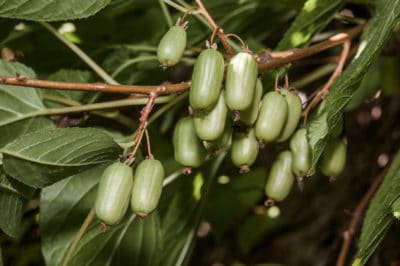Types of Kiwifruit
Although there are at least 50 different types of kiwi fruit, they fall into several major groups. Fuzzy or hairy kiwi is the common grocery store variety, Actinidia deliciosa. A similar form is the golden kiwifruit, A. chinensis. The Arctic kiwi is Actinidia kolomikta. Actinidia arguta is the hardy kiwifruit. The flesh may be green or yellow and size varies from a large grape to an egg.
Kiwifruit Hardiness
Actinidia deliciosa and Actinidia chinensis are warm-season fruits, best in USDA Zones 7 to 10. They have little frost tolerance and prefer mild winters. Actinidia kolomikta and Actinidia arguta can also be grown in those zones. However, since they can tolerate winter temperatures as low as -30°F (-34°C), they expand the range for kiwifruit into Zone 4 and may grow in Zone 3.
Choosing Varieties
You have many options for kiwifruit. Among these are:
- Ananasnaya – late August to September
- Dumbarton Oaks – early August to September
- 55 – ripens in July
- Hayward – November to December
- Meader – mid to late September
- Blake – late September to early October
- Arctic Beauty – early to mid-August.
How Kiwifruit Ripen
Kiwifruit ripen over a period of time rather than all at once. For the home gardeners, this allows you to pick fruits at maximum ripeness. Hardy kiwifruit grow in clusters and the individual fruits in a cluster also ripen at different times. You can pick individual fruits, but most people pick the cluster and let the fruit finish ripening at room temperature.
“Official” Season for Kiwifruit
In the US, most commercial kiwifruits are grown in California. These fruits ripen in late fall and are generally available in November, December and January, although they may be kept in cold storage to extend the season to mid-spring. Hardy kiwi fruits may be available as early as July. Imported kiwi fruit is often available in the summer months when grown in tropical areas.
Growing Kiwifruit
You can grow kiwifruit in almost any soil, although it will do best in a slightly acidic soil. Fertilize every other month during the growing season. The massive vines require a lot of water and will not produce well if without it. Kiwifruit require sturdy trellises to support the vines that can grow as much as 40 feet in length. Pruning is also required in the dormant season.
